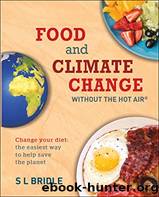Food and Climate Change Without the Hot Air by Sarah Bridle

Author:Sarah Bridle [Bridle, Sarah]
Language: eng
Format: epub
ISBN: 9780857845030
Google: LLMxygEACAAJ
Publisher: UIT Cambridge
Published: 2020-05-15T22:12:12.686185+00:00
Added ingredients
Chicken tikka masala recipes vary wildly, but many people fry chicken in butter with onions , garlic and spices and then simmer with tomatoes and cream. The environmental impact comes mostly from the chicken (Fig. 25.2 , left). The cream and butter cause about a quarter of the emissions, followed by the tomatoes. Even though the spices are the most important sensory ingredient, they hardly make any difference to the total emissions because we add only a few grams at most.
1 g spices = 1 g emissions
Fig. 25.2: Greenhouse-gas emissions estimates for chicken-tikka masala options:
Left: Emissions for chicken tikka masala: two tablespoons of butter, shared between 4 people (7.5 g); an onion, shared between 4 (42.5 g); two cloves of garlic, between 4 (5 g); spices (5 g); passata (100 g); cream (50 g); chicken (125 g); frying for 10 minutes, shared between 4 (2.5 minutes at 2 kW); simmering for 1 hour, shared between 4 people (15 minutes at 2 kW).
Centre: The same as the left panel, but using half the amount of chicken (62.5 g).
Right: The same as the centre panel, but switching butter to vegetable oil (7.5 g) and switching cream to 12.5 g of nut butter.
Download
This site does not store any files on its server. We only index and link to content provided by other sites. Please contact the content providers to delete copyright contents if any and email us, we'll remove relevant links or contents immediately.
Never by Ken Follett(2880)
Machine Learning at Scale with H2O by Gregory Keys | David Whiting(2291)
Fairy Tale by Stephen King(2069)
Will by Will Smith(2042)
Hooked: A Dark, Contemporary Romance (Never After Series) by Emily McIntire(1959)
The Dawn of Everything: A New History of Humanity by David Graeber & David Wengrow(1570)
The Becoming by Nora Roberts(1330)
A Short History of War by Jeremy Black(1300)
HBR's 10 Must Reads 2022 by Harvard Business Review(1256)
The Strength In Our Scars by Bianca Sparacino(1247)
Go Tell the Bees That I Am Gone by Diana Gabaldon(1234)
515945210 by Unknown(1207)
Bewilderment by Richard Powers(1083)
This Family Does It by Kevin Sellers(1080)
443319537 by Unknown(1072)
How to Live by Derek Sivers(1065)
The Real Anthony Fauci: Bill Gates, Big Pharma, and the Global War on Democracy and Public Health (Childrenâs Health Defense) by Robert F. Kennedy(1065)
Works by Richard Wright(1018)
Going There by Katie Couric(991)
